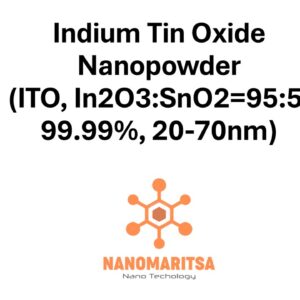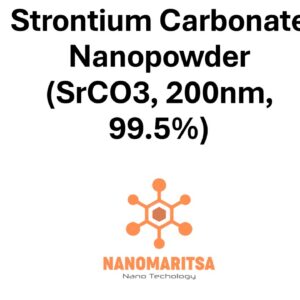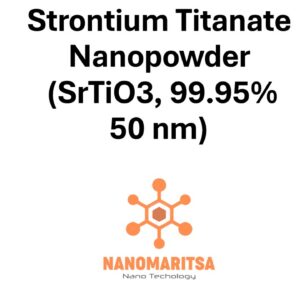Antimony Tin Oxide Nanopowder (ATO, SnO2:Sb2O3=90:10, 30nm, high purity, 99.95+%)
€100.00
CompareAntimony tin oxide (ATO) nanopowder is a doped metal oxide recognized for its unique combination of electrical conductivity and optical transparency. With a composition of 90% tin oxide (SnO₂) and 10% antimony oxide (Sb₂O₃), this high-purity (99.95+%) nanopowder features an average particle size of 30 nanometers. ATO’s nanoscale dimensions and controlled doping levels make it indispensable in applications requiring both conductivity and transparency, such as optoelectronic devices, sensors, antistatic coatings, and energy systems.
Composition and Structure
SnO₂:Sb₂O₃ = 90:10
By incorporating antimony oxide into tin oxide at a 90:10 ratio, ATO achieves enhanced electrical conductivity while maintaining good optical properties. The antimony ions substitute into the tin oxide lattice, introducing free carriers that increase conduction without significantly compromising transparency.
Purity (99.95+%)
The high purity ensures minimal contamination from other elements or compounds, which is crucial for maintaining consistent electrical performance and clarity in advanced electronic and optical devices.
Particle Size (30 nm)
With an average particle size of 30 nm, ATO nanopowder offers a high surface area that supports improved sinterability, uniform film formation, and better dispersion in composite materials.
Properties
Electrical Conductivity and Transparency
ATO nanopowder provides conductivity through controlled doping while retaining substantial transparency in the visible region. This makes it ideal for transparent electrodes, coatings, and antistatic layers.
Thermal and Chemical Stability
The doped oxide structure exhibits stability at elevated temperatures and resists chemical degradation, ensuring reliability in harsh or reactive environments.
Antistatic and EMI Shielding
Due to its conductive nature, ATO effectively dissipates static charges and can also serve as an electromagnetic interference (EMI) shielding layer, beneficial in electronics manufacturing and sensitive instrumentation.
Uniform Thin Films
The fine particle size and high purity support the production of dense, uniform thin films with consistent conductivity and optical properties, reducing production costs and improving device performance.
Applications
Transparent Conductive Coatings
ATO nanopowder is widely used to create transparent and conductive layers for touchscreens, displays, and thin-film solar cells, balancing conduction and optical clarity.
Antistatic and EMI Shielding Films
Its conductivity allows for the dissipation of electrostatic charges on sensitive components and the mitigation of EMI in electronic enclosures and devices.
Optoelectronics and Sensors
Thanks to its conductivity and transparency, ATO finds use in optoelectronic devices such as LEDs, photodetectors, and various sensors where minimal light obstruction and stable conduction are vital.
Smart Windows and Energy Systems
ATO is explored in smart windows that regulate light transmission and in energy storage or conversion systems where conductive coatings are needed for efficient charge transfer.
Protective and Decorative Coatings
Beyond electronics, ATO-based coatings can offer both functional (e.g., antistatic, conductive) and aesthetic (e.g., reflective, tinted) benefits in architectural and automotive applications.
Recent Advancements and Research Contributions
Massachusetts Institute of Technology (MIT), USA
Investigating low-temperature sintering techniques to fabricate flexible, transparent ATO films for wearable electronics and flexible displays.
Tsinghua University, China
Developing roll-to-roll coating processes for large-area ATO thin films, focusing on improved conductivity-to-transparency ratios in solar cells and smart windows.
National University of Singapore (NUS)
Exploring hybrid ATO nanocomposites in advanced sensors for healthcare monitoring, leveraging the fine particle size for higher surface interactions.
University of Cambridge, UK
Optimizing doping levels in ATO nanopowder to achieve consistent conduction in next-generation optoelectronic devices, with attention to scalable production and environmentally friendly solvents.
Recent Developments
- Printable Inks: Formulating ATO nanopowder into conductive inks for inkjet or screen printing, enabling low-cost manufacturing of transparent, conductive patterns.
- Hybrid Nanocomposites: Integrating ATO with graphene or carbon nanotubes to improve mechanical robustness and further tailor optical and electrical properties.
- Green Synthesis Approaches: Employing eco-friendly solvents and production methods that reduce energy consumption and waste, aiding large-scale manufacturing.
Future Prospects
Antimony tin oxide nanopowder (SnO₂:Sb₂O₃ = 90:10, 30 nm, 99.95+% Purity) underpins modern developments in transparent electronics, sensors, and energy-saving technologies. As research progresses, this material is expected to:
- Advance the performance of flexible, high-resolution displays and smart windows.
- Enhance energy harvesting in photovoltaic cells via transparent electrode layers.
- Facilitate the manufacture of next-generation sensors and optoelectronic components through printable, low-temperature fabrication methods.
By uniting conductivity and transparency in a thermally and chemically robust form, ATO nanopowder stands as a key enabler in sophisticated electronic, optical, and energy applications, driving sustainable innovation across diverse industries.
| Measurement (gr) | 100 grams, 500 grams, 1000 grams |
|---|






